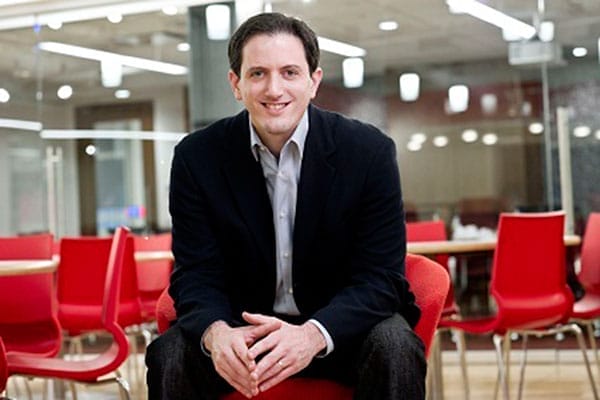It’s not all the time that Jonathan Zabusky, W’95, gets a call from a Fortune 500 company asking him to become an executive officer at one of its subsidiaries. But when it happens, it works out. In 2007, he was living in San Francisco finishing up a stint at Barclays Global Investors. He was looking to move back East when he received a call from Aramark. Essentially, the Philadelphia-based professional services giant wanted him to become vice president of strategic development and help integrate its new acquisition, Seamless, a corporate food delivery service. By December 2009, Aramark promoted him to head the whole subsidiary.
He’s helped engineer two major undertakings since then, which have placed him in the forefront of the food tech world.
First, he helped turn Seamless from a B2B company to a B2C company, and to do so, he needed to spin the business out of Aramark, which happened in June 2011, making him CEO of the newly independent company. An acquisition soon followed—of MenuPages in October 2011—and before long, Seamless was positioning itself ahead of industry trends. The biggie being mobile.
“We thankfully made a big bet in mobile several years ago,” he said, adding that about half of all online consumer food orders are now done with a mobile device. “All of the things we do are rolled out mobile first.”
The other significant move was the merger of Seamless with GrubHub in 2013, thereby bringing together two leaders in the mobile food delivery and pickup market. As Zabusky told the story (delivering a keynote speech in November at the 2014 BizTech Conference organized by Wharton MBA students), GrubHub wanted access to the New York City metropolitan area, London and exclusive corporate accounts from thousands of corporate clients, which Seamless has, and Seamless got access to everywhere else where GrubHub has a stronghold. Now president and member of the board of directors of the newly merged company doing business as GrubHub Inc., with both Seamless and GrubHub as operating brands, Zabusky was optimistic about the partnership, though he noted that bringing two successful firms together can be challenging, like a marriage. GrubHub went public in April 2014 and, as of this writing, had a market cap north of $2.8 billion. It appears to be an extended honeymoon.

Opportunities ahead appear even more supersized. In a recent Forbes article, GrubHub CEO Matt Maloney estimated that American consumers spend $70 billion annually on takeout and delivery food. About one-tenth of that is done online, according to Zabusky’s numbers. One would assume that that ratio is only going to slant more toward mobile as more consumers and restaurants adopt mobile devices. Mobile ordering, Zabusky said, doesn’t necessarily cannibalize desktop ordering; it helps to drive more consumers from analog to online.
“It’s started to accelerate the pace of growth,” he told the audience about mobile.
“Growth” is a good word to describe the overall food tech scene. From Zabusky’s vantage, he sees an aggressive funding environment with capital going to many different ideas. A couple “uber trends,” he said, are becoming apparent around health and wellness promotion, and around saving consumers time and money.
In the wider universe of mobile, the big trend is payments, and the new GrubHub is positioned to be agnostic on payment platforms as a payment processor—making this payments trend neither a big threat nor opportunity, just another way for the business to grow.
Perhaps the only threat to online food ordering would be if a mass diet breaks out. There again, though, lies another opportunity for Zabusky, if and when another massive corporation calls for its next leader.

























